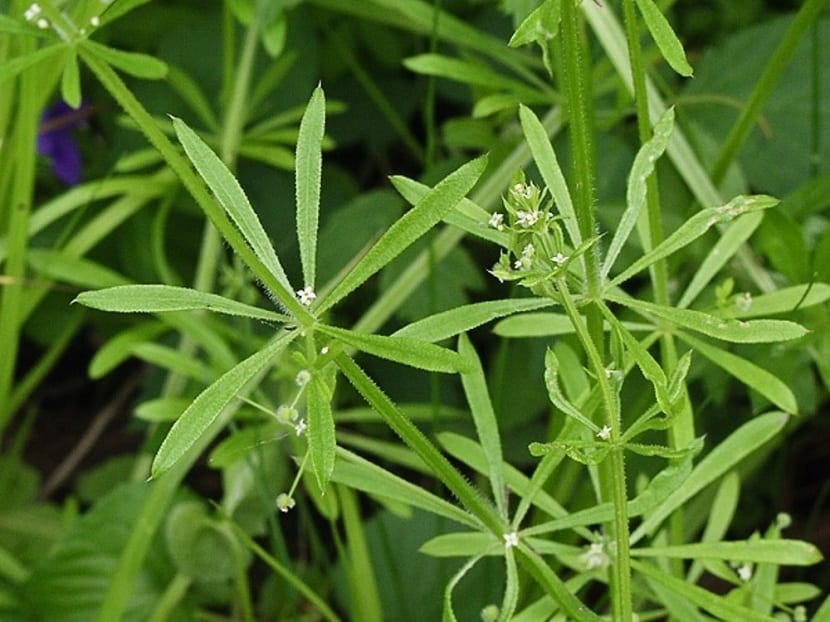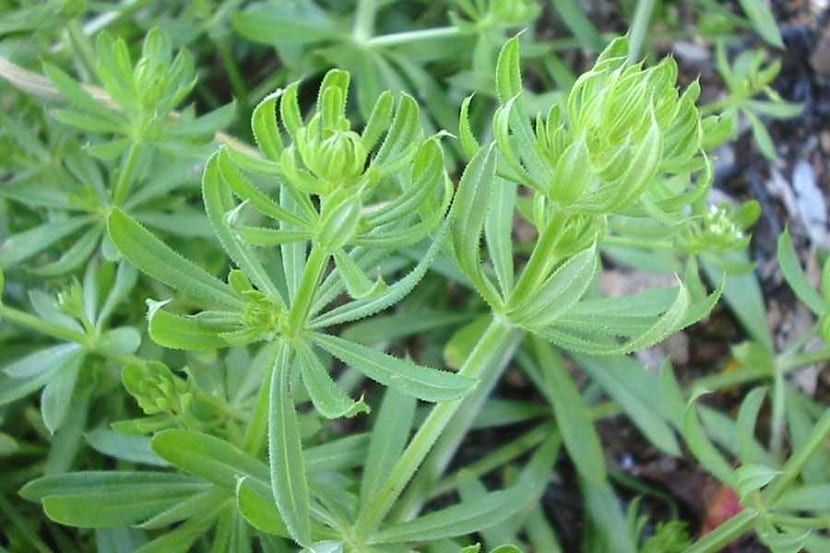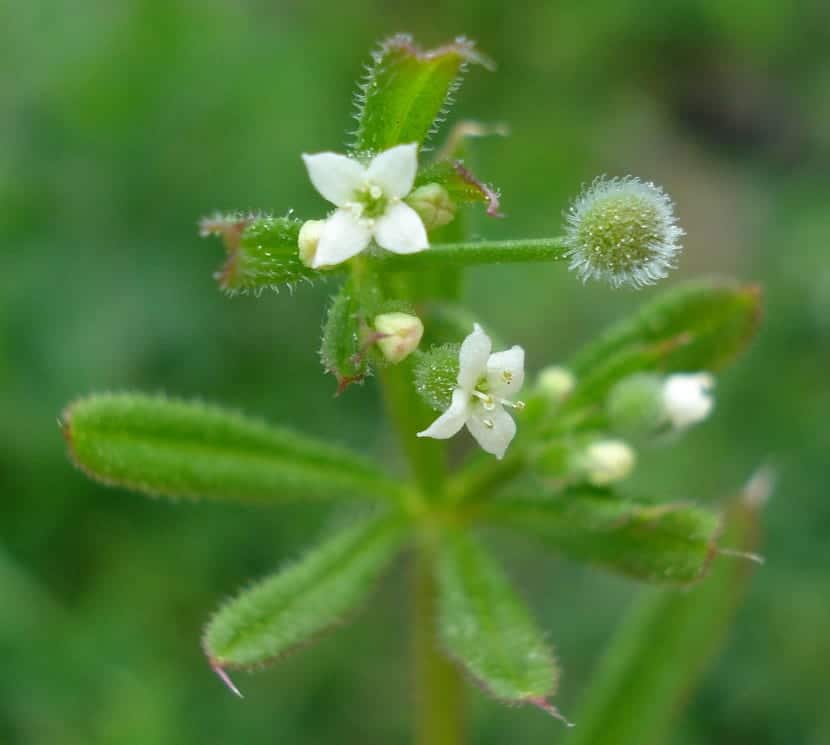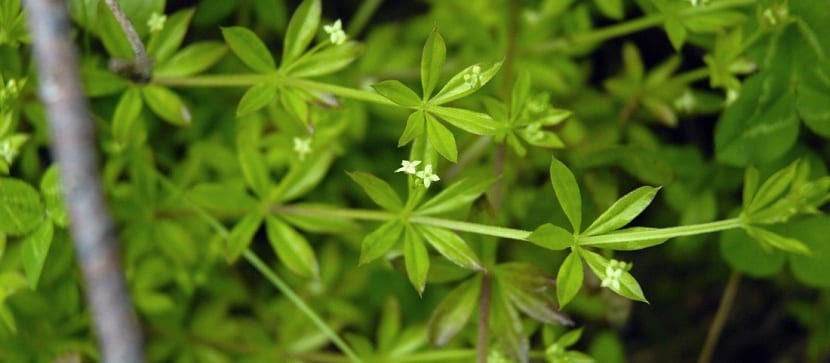
One of the medicinal plants capable of self-pollination is the Galium aparine. It is a plant that belongs to the Rubiaceae family and is known by the common names of gardener love, tongue whipper, walkers friend, ortholano love, limpet and clingy, among others. It is a plant native to Europe and North and West Asia. It is used on numerous occasions as a medicine for the treatment of some pathologies.
In this article we are going to tell you everything you need to know about the characteristics and properties of Galium aparine.
Key features

It is a plant that can reach up to 1,2 meters high and three meters wide. It has the ability to self-pollinate, which is why it is considered a hermaphrodite. This helps tremendously to its expansion in the spaces where it is, since its reproduction is quite accelerated. Although it can reproduce on its own, they also sometimes use Diptera or Coleoptera to spread their pollen between flowers.
The flowers are white and have some kelly touches. One of the functions that it has if you place them in a garden is that it is capable of attracting wildlife. It is an annual herb with climbing characteristics. In the natural environment it grows in wet grassland areas. These areas can be understory scrub, gutters, and various crops.
There are also those who considers them within the ruderal plants or better known as weeds. This is because they appear very frequently in cereal crops and compete for the nutrients of these crops.
It is covered by a series of stiff, hook-shaped hairs. These hairs help them to adhere to other plants or support to continue climbing as it grows. It has lanceolate and elliptical leaves. The edges of the leaves also have hairs and a midrib with a deep green color. Its flowers are grouped in cymes and are white and small with 4 petals at the base. Flowering time is early spring.
The fruit is not edible and has a globose shape. It forms two symmetrical parts that are covered with hooked hairs.
Caring for the Galium aparine

Although it is not a plant that stands out for its beauty or has a great use as an ornamental plant, there are those who have it in the garden as a climbing plant. To be able to take good care of it, it needs a location in full sun. In order for it to develop well and grow in good conditions, it needs the maximum number of hours of sunlight a day.
The soil needs to have good organic nutrients. If not, it is convenient to fertilize it with manure or worm castings. Before watering, it needs to be moderate throughout the year. The indicator for knowing when to water is for the soil to stay dry. This works for both winter and summer. It is necessary that, during irrigation, we do not flood the plant at the base because we can drown them. Likewise, the soil needs good drainage so that water does not accumulate.
During irrigation it is somewhat easier to control the water that accumulates on the ground in case of not having a good drainage. However, we cannot do the same when it rains. As for temperatures, it is not able to withstand frost, or cold temperatures frequently in winter. Therefore, we need a climate with milder winters. If it is continuously exposed to very low temperatures, we can cause severe damage or even death.
It is not a plant that is prone to different types of diseases or pests. As it does not have great capacity to adapt to cold nor does it need humid environments, it is not usually affected by any pest or disease.
Main uses

This plant is used with some medicinal tendencies. There are different scientific theories or research. Its efficacy in humans has not been fully proven. but it was possible to evaluate a qualified medical provider.
It has various uses such as anti-inflammatory, antipyretic, used to treat blisters and as a blood purifier. Many people have used it to treat the common cold, making infusions, making creams for the treatment of dandruff and as a solution to diarrhea problems, thanks to its diuretic effect.
The only evidence of its efficacy has been experienced in humans or animals. Its use in humans has not always been demonstrated. For these types of conditions, It is better to go to a specialist and see if he guarantees the use of the Galium aparine for your treatment.
To be able to use it in some treatments, you must first collect them a little before flowering and let them dry for a long time. Once dried, they can be used to take in infusions in some internal problems such as diarrhea and as a cream for some external problems such as a blister.
Among the properties of Galium aparine It is found that it adheres easily to garments thanks to the small stolons that it has on the entire surface. These hairs make it stick to clothing and its fruits, which contain the seeds, can spread better for their reproduction. Although it is able to pollinate itself, uses these techniques to increase reproductive success.
Another of its traditional uses is that it was used to curdle milk. The ground seeds also make a coffee substitute.
Since it is a plant that causes various allergy situations, it is advisable to supervise a medical specialist to see if it can cause any type of side effect. Too There are people to whom it causes allergies and it is better to know the possible effects. The allergy can have several effects both internally if it is taken as an infusion and external if it is used as a cream to treat blisters.
As you can see, the Galium aparine It is used in different treatments of pathologies in addition to being used as a climbing plant. I hope this information helps you learn more about it.